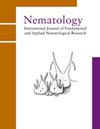Susceptibility of seven strawberry cultivars to Belonolaimus longicaudatus and interaction with Phytophthora cactorum
IF 1.2
4区 生物学
Q2 ZOOLOGY
引用次数: 0
Abstract
Belonolaimus longicaudatus and Phytophthora cactorum are pathogens threatening Florida strawberry production. The interaction among these and cultivar susceptibility were assessed in this study. Cultivars ‘Sensation® Florida127’, ‘Florida Brilliance’, ‘Florida Radiance’, ‘Winterstar™ FL 05-107’, ‘Florida Elyana’, ‘Strawberry Festival’ and ‘Florida Beauty’ were used to conduct one trial using plug transplants and a second trial using bare-root transplants, which was repeated twice. A factorial combination of P. cactorum (+/−) and B. longicaudatus (+/−) inoculation was applied to evaluate strawberry cultivar resistance to P. cactorum and B. longicaudatus as well as their interaction. The effect of P. cactorum on the canopy, root length, and root and shoot weight was dependent on cultivars. For the plug transplant trial, the overall average of plant mortality among all tested strawberry cultivars was 0.1%, suggesting higher tolerance against P. cactorum when vigorous transplants were used. Conversely, the repeated bare-root transplant trial demonstrated different levels of susceptibility in strawberry cultivars when transplants were inoculated with P. cactorum. ‘Sweet Sensation’ ‘Florida127’, ‘Florida Brilliance’, ‘Florida Radiance’ and ‘Winterstar FL 05-107’ were highly susceptible, whereas ‘Florida Elyana’ and ‘Strawberry Festival’ were resistant. Moreover, ‘Florida Beauty’ was moderately resistant to P. cactorum. Our findings demonstrated the importance of using vigorous transplants to reduce P. cactorum damage. Sting nematode reproduction was suppressed when strawberry transplants were inoculated with P. cactorum, suggesting an antagonistic interaction between the pathogens. None of the cultivars was tolerant to B. longicaudatus as this nematode reproduced from 13.4- to 23.8-fold and caused root damage under glasshouse conditions.7个草莓品种对长尾贝洛菌的敏感性及与仙人掌疫霉的相互作用
长尾贝洛菌和仙人掌疫霉是威胁佛罗里达草莓生产的病原体。本研究评估了它们之间的相互作用和品种易感性。品种“Sensation®Florida127”、“Florida Brilliance”、“佛罗里达光辉”、“Winterstar”™ FL 05-107、Florida Elyana、Strawberry Festival和Florida Beauty被用于进行一项使用塞子移植的试验和第二项使用裸根移植的试验,重复两次。采用仙人掌P.cactorum(+/−)和长尾B.longicadus(+/–)接种的因子组合来评估草莓品种对仙人掌P.cactoraum和长尾B.Longicadus的抗性及其相互作用。仙人掌对冠层、根长和根冠重的影响取决于品种。在插塞移植试验中,所有受试草莓品种的植物死亡率总体平均值为0.1%,这表明当使用强有力的移植时,对仙人掌的耐受性更高。相反,重复的裸根移植试验表明,当移植植物接种仙人掌时,草莓品种的易感性水平不同Sweet Sensation“Florida127”、“Florida Brilliance”、“佛罗里达Radiance”和“Winterstar FL 05-107”高度易感,而“FloridaElyana”和“草莓节”则具有抗性。此外,“佛罗里达美人”对仙人掌具有中等抗性。我们的研究结果证明了使用强有力的移植来减少仙人掌损伤的重要性。当草莓移植体接种仙人掌霉时,刺线虫的繁殖受到抑制,这表明病原体之间存在拮抗作用。在温室条件下,没有一个品种对长尾B.long尾状线虫具有耐受性,因为这种线虫的繁殖量为13.4至23.8倍,并造成根系损伤。
本文章由计算机程序翻译,如有差异,请以英文原文为准。
求助全文
约1分钟内获得全文
求助全文
来源期刊

Nematology
生物-动物学
CiteScore
2.60
自引率
33.30%
发文量
67
审稿时长
3 months
期刊介绍:
Nematology is an international journal for the publication of all aspects of nematological research (with the exception of vertebrate parasitology), from molecular biology to field studies. Papers on nematode parasites of arthropods, and on soil free-living nematodes, and on interactions of these and other organisms, are particularly welcome. Research on fresh water and marine nematodes is also considered when the observations are of more general interest.
Nematology publishes full research papers, short communications, Forum articles (which permit an author to express a view on current or fundamental subjects), perspectives on nematology, and reviews of books and other media.
 求助内容:
求助内容: 应助结果提醒方式:
应助结果提醒方式:


